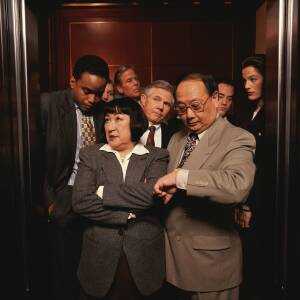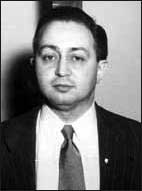Related Topics
Outlaws: Crime in Philadelphia
Even the criminals, the courts and the prisons of this town have a Philadelphia distinctiveness. The underworld has its own version of history.
Philadelphia Physicians
Philadelphia dominated the medical profession so long that it's hard to distinguish between local traditions and national ones. The distinctive feature is that in Philadelphia you must be a real doctor before you become a mere specialist.
Architecture in Philadelphia
Originating in a limitless forest, wooden structures became a "Red City" of brick after a few fires. Then a succession of gifted architects shaped the city as Greek Revival, then French. Modern architecture now responds as much to population sociology as artistic genius. Take a look at the current "green building" movement.

Hospital Elevators

|
| Modern, High-Speed Elevator |
Elevators are a problem for any architect in any building, because they are expensive in a number of ways. If the building is no more than four stories high, it can manage to have hydraulic elevators, quite sturdy and comparatively inexpensive, but agonizingly slow. Taller buildings need high-speed electric versions, but the elevator itself is not the most expensive part. More important is that every elevator bores a hole in every floor, more elevators bore more holes, and the usable floor space on each floor is reduced. Further, the mechanical stress is mostly on the doors on each floor, which open and close hundreds of times each day, rather than the lifting engine of the cab. Elevators which seem to be breaking down continually, are mostly in need of new doors. In building a hospital, the architect confers closely with the administrator until the place is built and then the architect leaves. The administrator may leave soon afterward, too, because the hospital personnel who use the new building soon discover that when pennies were pinched, the result was fewer elevators. There's no right answer to this problem; nobody is ever satisfied.

|
| Waiting for the Elevator |
The surgeons long ago learned to cope with the problem by beginning their day before everyone else arrives. If the elevator comes immediately after being summoned and skips all intervening floors to the surgeon's destination, it can save at least a half hour of his time to make rounds at 5 AM. Multiply that imposed delay on hundreds or thousands of hospital employees, and it is possible to conjecture that hospital employees generally only work a 7-hour day, and spend the 8th hour waiting for the elevator. Whatever the actual calculation, it is a cost seldom actually calculated into the equation of constraining the installation of elevators because of cost considerations. Unwelcome crowding is a social cost, too. Bereaved relatives coming down in the elevator must meet students of various disciplines going up the elevator holding coffee cups and chattering. And all ranks and conditions must crowd into the unyielding back of the elevator when the door opens to confront a hospital bed with an afflicted patient aboard, surrounded by a team of attendants in pajamas, holding up bottles and tubes. Attempts are usually made to assign separate elevators for patients and/or equipment, but the attendants soon find out about elevators that save time, flocking to them in spite of signs, threats, administrative letters of admonishment, and dreary staff meetings. It is easy to identify new staff; they are the people who take elevators down. Everyone else learns to go to the top floor and walk down the stairwells. Outta my way!

|
| Harry Gold |
So, hospital elevators evoke recollections. Mine include the many times I rode up beside a sullen teenager named Harry Gold, who was going to the chemistry department of the old Philadelphia General Hospital. If we ever exchanged a word I don't remember it, so I have to regret that I missed out on striking up an acquaintance with a real, convicted Soviet spy, the one who passed hydrogen bomb secrets to those Rosenbergs who went to the electric chair protesting their innocence. Something to tell my grandchildren I guess.
On another occasion, Dr. John Y. Templeton was standing impatiently for an elevator at Jefferson Hospital. John was a brilliant surgeon from Virginia, one of the inventors of the heart-lung machine, and also one of the quickest, most irreverent wits in Medicine. The door of the elevator opened, to reveal a completely crowded crowd of assorted folk, with a Doctor Zimskind standing in the front. Templeton's southern accent boomed out, "Going down?" "Going dow-un?" Lost in thought, Zimskind had trouble finding his voice and simply poked his index finger skyward two or three times. To which, Templeton shouted out, "The same to you, Dr. Zimskind. But are you going dow-un?"
And, much earlier when I was a resident wearing a long white coat, accompanied by a jolly sort named Carroll who wore the same, we got on an elevator which was empty except for a surgical resident wearing his particular uniform of a short white coat covering his green surgical pajamas. We had gossiped earlier about this surgeon, who had returned for training after some harrowing experiences in the Normandy beachhead. He was a mean, silent, sort, but Carroll was an irrepressible joker. "Well," sez Carroll, "I hear you carry a gun around with you. Do you carry it into the operating room?" To this, the surgical resident opened his jacket and, so help me, pulled out a pistol from his belt. "When I was in Germany," he murmured, "I killed lots of better men than you are." Under the circumstances, there was little more to be said, and we stopped breathing just to be sure. Those Jefferson elevators are awfully slow to reach the next floor.
And finally, there was Herman, who ran the hydraulic elevator in the original old building of the Pennsylvania Hospital. Herman the German we called him, although his accent was probably Central European. This elevator was an antique, with a big iron steering wheel that Herman turned to release the oil or water or whatever pumped the excruciatingly slow cage up two floors. There, for our contemplation, was America's first building of the first hospital, with the first operating room on the top floor. For more than a century, orderlies had to carry stretchers up and down the stairs with the apprehensive surgical patients, and then this marvel of a hydraulic thing was installed to great admiration. It has long been replaced with a fancy new self-service elevator. But so have the patients been replaced; one hundred sixty patient beds entirely replaced by administrators.
Originally published: Wednesday, September 24, 2008; most-recently modified: Tuesday, May 21, 2019